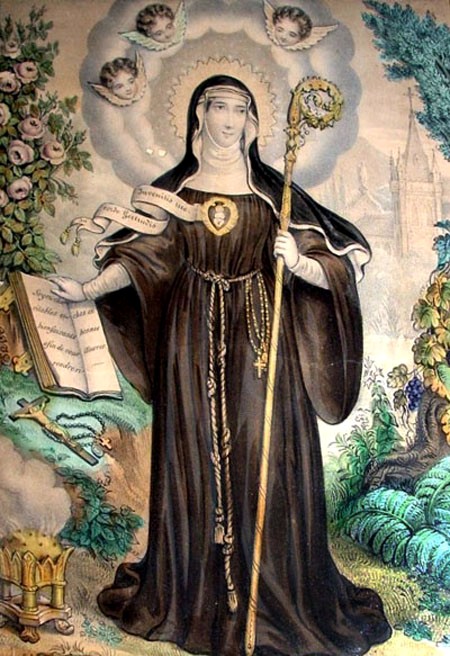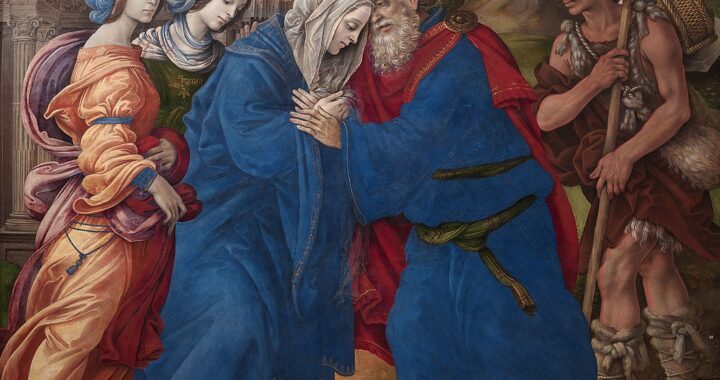
Wikimedia Commons
Each year on November 2, the Church invites us to pray for all the faithful departed who have not yet entered into Heaven. Now commonly called the poor souls in Purgatory, these are the baptized men, women, and children who have died, desire to spend eternity with God, and need to be purified of their faults before entering into Heaven. (Find out more in the Catechism of the Catholic Church, nos. 1020-1060.)
How can Saint Gertrude the Great (c. 1256-c. 1302) help us pray for those who have already left this world, both those we know and those we don’t? Before we learn about Gertrude’s prayer, we should learn about her life.
Gertrude was five years old when she was sent to be educated by nuns in Eisleben, Germany. There is much we don’t know about her early years, such as her parents’ names and whether the nuns were members of the Benedictine order or the Cistercian order. But it was a common practice for noble families to send their children to monastic schools, and Gertrude appears to have enjoyed her life among the nuns. After all, she chose to stay and be professed as a nun herself when she grew up.
From a purely intellectual perspective, Gertrude had good reasons to be happy at the Monastery of Helfta. Her teachers quickly realized she was an intelligent student. The convent library contained both religious works and secular writings, and she happily studied both as a young nun.
Gertrude made friends at the monastery too. One of the nuns in particular had befriended her when she was young, and that friendship became a friendship of equals when Gertrude grew up. But Saint Mechtilde of Helfta (c. 1241-c. 1298), as she is now known, was more than just a nun. She was a humble woman with a love of prayer, and she shared her mystical experiences with Gertrude. Unbeknownst to Mechtilde, Gertrude faithfully recorded all Mechtilde’s visions, though she only told Mechtilde about it near the end of her life. Mechtilde’s spiritual writings were later collected and published as The Book of Special Grace.
But one does not become a nun for the sake of making friends or reading books. One day when Gertrude was twenty-six years old and was praying, our Lord appeared and spoke to her. She called this pivotal moment her conversion, although the devout young nun was not living a life of sin. But it certainly converted her to a life of wholehearted love for Jesus Christ.
Gertrude set aside her study of secular works and devoted herself to the study of the Bible, the liturgy, the Fathers of the Church, and other great theologians. She received many visions, which she tried to understand with the mind of the Church. She wrote down her insights to share with her sisters, and she composed prayers that inspired the whole community.
The image of Saint Gertrude at the top of this article shows her with a book (representing her Scriptural studies and her own writings) and her rosary and crucifix (representing her love of God and prayer), with her monastery in the background. The depiction of Jesus Christ hidden in her heart reminds us of the details from one of her visions, but it also points to Gertrude’s devotion to the Sacred Heart of Jesus, which she promoted almost four centuries before Saint Margaret Mary Alacoque. One detail in this image—and in almost every image of Saint Gertrude—is apparently wrong. She is often shown holding a crozier, the shepherd’s crook that indicates the position of abbess. Gertrude was apparently not an abbess, but the woman who was her abbess was named Gertrude, which later led to confusion.
Many prayers are popularly attributed to Saint Gertrude. Some of them were written by her, but others were written by members of her community. If any of those prayers inspire us to pray more deeply to God, Gertrude and her nuns would not be concerned about who gets the credit for composing them.
But she really did write this famous prayer:
Eternal Father, I offer Thee the Most Precious Blood of Thy Divine Son, Jesus, in union with the Masses said throughout the world today, for all the holy souls in Purgatory, for sinners everywhere, for sinners in the universal Church, for those in my own home and within my family. AMEN.
Some say that Gertrude taught that praying this prayer would release a thousand souls from Purgatory. Perhaps that’s the case when Gertrude prayed it. For the rest of us, it is enough to pray it as fervently as possible for those who can no longer pray for themselves and to trust that God hears us, particularly on All Souls’ Day.
